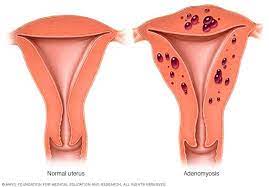
Adenomyosis is a condition in which endometrial glands and/ or stroma are encountered in the uterine musculature. This ectopic endometrium continues to function normally by thickening, breaking down and bleeding during each menstrual cycle.
Incidence may vary with age of the patients from less than 20 % in women below 40 years of age, to 60% between 40-55 years of age
Abnormal utero-tubal transport seems to be an important mechanism leading to infertility in these patients due to anatomical distortion of the uterine cavity, disturbed uterine peristalsis and sperm transport
Symptoms
Adenomysis may cause no signs or symptoms or only mild discomfort, however it can cause:
- Heavy or prolonged menstrual bleeding
- Severe cramping or sharp pain during menstruation (dysmenorrhea)
- Chronic pelvic pain
- Painful intercourse (dyspareunia)
Diagnosis
The development of imaging techniques, such as MRI and transvaginal ultrasonography, has allowed clinicians to make a non-invasive diagnosis of Adenomysis.
Transvaginal ultrasonography: Asymmetrical thickening of uterine walls, intramyometrial cysts, interrupted junctional zone.
Magnetic resonance imaging: Is essentially related to the thickening of the junctional zone.
- History
- Prior uterine surgery, such as C-section, fibroid removal, or dilatation and curettage (D&C)
- Childbirth
- Middle age women
Risk factors for Adenomysis include
Complications
If you often have prolonged, heavy bleeding during your periods, you can develop chronic anemia, which causes fatigue and other health problems.
Although not harmful, the pain and excessive bleeding associated with adenomyosis can disrupt your lifestyle.
Treatment
The choice of treatment depends on the woman’s age, reproductive status, and clinical symptoms.
